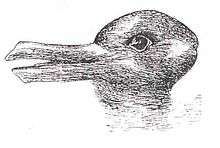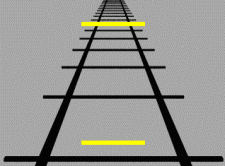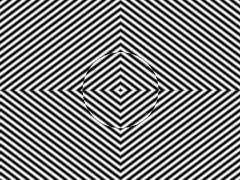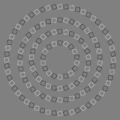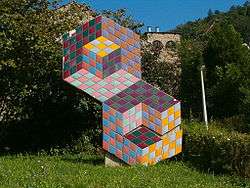Optical illusion

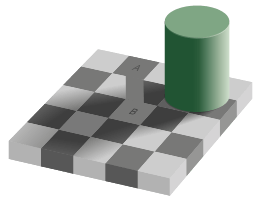
An optical illusion (also called a visual illusion) is an illusion caused by the visual system and characterized by visually perceived images that differ from objective reality. The information gathered by the eye is processed in the brain to give a percept that does not tally with a physical measurement of the stimulus source. There are three main types: literal optical illusions that create images that are different from the objects that make them, physiological illusions that are the effects of excessive stimulation of a specific type (brightness, colour, size, position, tilt, movement), and cognitive illusions, the result of unconscious inferences. Pathological visual illusions arise from a pathological exaggeration in physiological visual perception mechanisms causing the aforementioned types of illusions.
Optical illusions are often classified into categories including the physical and the cognitive or perceptual,[1] and contrasted with optical hallucinations.

Physiological illusions, such as the afterimages[2] following bright lights, or adapting stimuli of excessively longer alternating patterns (contingent perceptual aftereffect), are presumed to be the effects on the eyes or brain of excessive stimulation or interaction with contextual or competing stimuli of a specific type—brightness, color, position, tile, size, movement, etc. The theory is that a stimulus follows its individual dedicated neural path in the early stages of visual processing, and that intense or repetitive activity in that or interaction with active adjoining channels cause a physiological imbalance that alters perception.
The Hermann grid illusion and Mach bands are two illusions that are best explained using a biological approach. Lateral inhibition, where in the receptive field of the retina light and dark receptors compete with one another to become active, has been used to explain why we see bands of increased brightness at the edge of a color difference when viewing Mach bands. Once a receptor is active, it inhibits adjacent receptors. This inhibition creates contrast, highlighting edges. In the Hermann grid illusion the gray spots appear at the intersection because of the inhibitory response which occurs as a result of the increased dark surround.[3] Lateral inhibition has also been used to explain the Hermann grid illusion, but this has been disproved. More recent empirical approaches to optical illusions have had some success in explaining optical phenomena with which theories based on lateral inhibition have struggled (e.g. Howe et al. 2005).[4]
Pathological visual illusions
A pathological visual illusion is a distortion of a real external stimulus[5] and are often diffuse and persistent. Pathological visual illusions usually occur throughout the visual field, suggesting global excitability or sensitivity alterations.[6] Alternatively visual hallucination is the perception of an external visual stimulus where none exists.[5] Visual hallucinations are often from focal dysfunction and are usually transient.
Types of visual illusions include oscillopsia, halos around objects, illusory palinopsia (visual trailing, light streaking, prolonged indistinct afterimages), akinetopsia, visual snow, micropsia, macropsia, teleopsia, pelopsia, Alice in Wonderland syndrome, metamorphopsia, dyschromatopsia, intense glare, blue field entoptic phenomenon, and purkinje trees.
These symptoms may indicate an underlying disease state and necessitate seeing a medical practitioner. Etiologies associated with pathological visual illusions include multiple types of ocular disease, migraines, hallucinogen persisting perception disorder, head trauma, and prescription drugs. If a medical work-up does not reveal a cause of the pathological visual illusions, the idiopathic visual disturbances could be analogous to the altered excitability state seen in visual aura with no migraine headache. If the visual illusions are diffuse and persistent, they often affect the patient's quality of life. These symptoms are often refractory to treatment and may be caused by any of the aforementioned etiologes, but are often idiopathic. There is no standard treatment for these visual disturbances.
Cognitive illusions
Cognitive illusions are assumed to arise by interaction with assumptions about the world, leading to "unconscious inferences", an idea first suggested in the 19th century by the German physicist and physician Hermann Helmholtz.[7] Cognitive illusions are commonly divided into ambiguous illusions, distorting illusions, paradox illusions, or fiction illusions.
- Ambiguous illusions are pictures or objects that elicit a perceptual "switch" between the alternative interpretations. The Necker cube is a well-known example; another instance is the Rubin vase.
- Distorting or geometrical-optical illusions are characterized by distortions of size, length, position or curvature. A striking example is the Café wall illusion. Other examples are the famous Müller-Lyer illusion and Ponzo illusion.
- Paradox illusions are generated by objects that are paradoxical or impossible, such as the Penrose triangle or impossible staircase seen, for example, in M.C. Escher's Ascending and Descending and Waterfall. The triangle is an illusion dependent on a cognitive misunderstanding that adjacent edges must join.
- Fictions are when a figure is perceived even though it is not in the stimulus.
Explanation of cognitive illusions
Perceptual organization

To make sense of the world it is necessary to organize incoming sensations into information which is meaningful. Gestalt psychologists believe one way this is done is by perceiving individual sensory stimuli as a meaningful whole.[8] Gestalt organization can be used to explain many illusions including the rabbit–duck illusion where the image as a whole switches back and forth from being a duck then being a rabbit and why in the figure–ground illusion the figure and ground are reversible.
In addition, Gestalt theory can be used to explain the illusory contours in the Kanizsa's Triangle. A floating white triangle, which does not exist, is seen. The brain has a need to see familiar simple objects and has a tendency to create a "whole" image from individual elements.[8] Gestalt means "form" or "shape" in German. However, another explanation of the Kanizsa's Triangle is based in evolutionary psychology and the fact that in order to survive it was important to see form and edges. The use of perceptual organization to create meaning out of stimuli is the principle behind other well-known illusions including impossible objects. Our brain makes sense of shapes and symbols putting them together like a jigsaw puzzle, formulating that which isn't there to that which is believable.
The Gestalt principles of perception govern the way we group different objects. Good form is where the perceptual system tries to fill in the blanks in order to see simple objects rather than complex objects. Continuity is where the perceptual system tries to disambiguate which segments fit together into continuous lines. Proximity is where objects that are close together are associated. Similarity is where objects that are similar are seen as associated. Some of these elements have been successfully incorporated into quantitative models involving optimal estimation or Bayesian inference. [9][10]
The double-anchoring theory, a popular but recent theory of cognitive illusions, states that any region belongs to a framework of Gestalt principles and within each framework, is independently anchored a highest surrounding brightness and highest brightness. A spot's lightness is determined by using the average of values of brightness in each framework.[11]
Depth and motion perception

Illusions can be based on an individual's ability to see in three dimensions even though the image hitting the retina is only two dimensional. The Ponzo illusion is an example of an illusion which uses monocular cues of depth perception to fool the eye. But even with two dimensional images, the brain exaggerates vertical distances when compared with horizontal distances, as in the vertical-horizontal illusion where the two lines are exactly the same length.
In the Ponzo illusion the converging parallel lines tell the brain that the image higher in the visual field is farther away therefore the brain perceives the image to be larger, although the two images hitting the retina are the same size. The optical illusion seen in a diorama/false perspective also exploits assumptions based on monocular cues of depth perception. The M.C. Escher painting Waterfall exploits rules of depth and proximity and our understanding of the physical world to create an illusion. Like depth perception, motion perception is responsible for a number of sensory illusions. Film animation is based on the illusion that the brain perceives a series of slightly varied images produced in rapid succession as a moving picture. Likewise, when we are moving, as we would be while riding in a vehicle, stable surrounding objects may appear to move. We may also perceive a large object, like an airplane, to move more slowly than smaller objects, like a car, although the larger object is actually moving faster. The phi phenomenon is yet another example of how the brain perceives motion, which is most often created by blinking lights in close succession.
The ambiguity of direction of motion due to lack of visual references for depth is shown in the spinning dancer illusion. The spinning dancer appears to be moving clockwise or counterclockwise depending on spontaneous activity in the brain where perception is subjective. Recent studies show on the fMRI that there are spontaneous fluctuations in cortical activity while watching this illusion, particularly the parietal lobe, because it is involved in perceiving movement.[12]
Color and brightness constancies
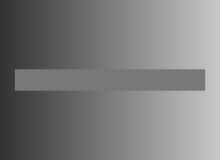
Perceptual constancies are sources of illusions. Color constancy and brightness constancy are responsible for the fact that a familiar object will appear the same color regardless of the amount of light or color of light reflecting from it. An illusion of color or contrast difference can be created when the luminosity or color of the area surrounding an unfamiliar object is changed. The contrast of the object will appear darker against a black field that reflects less light compared to a white field even though the object itself did not change in color. Similarly, the eye will compensate for color contrast depending on the color cast of the surrounding area.
In addition to the Gestalt principles of perception, water-color illusions contribute to the formation of optical illusions. Water-color illusions consist of object-hole effects and coloration. Object-hole effects occur when boundaries are prominent where there is a figure and background with a hole that is 3D volumetric in appearance. Coloration consists of an assimilation of color radiating from a thin-colored edge lining a darker chromatic contour. The water-color illusion describes how the human mind perceives the wholeness of an object such as top-down processing. Thus, contextual factors play into perceiving the brightness of an object.[13]
Object
Just as it perceives color and brightness constancies, the brain has the ability to understand familiar objects as having a consistent shape or size. For example, a door is perceived as rectangle regardless of how the image may change on the retina as the door is opened and closed. Unfamiliar objects, however, do not always follow the rules of shape constancy and may change when the perspective is changed. The Shepard illusion of the changing table[14] is an example of an illusion based on distortions in shape constancy.
Future perception
Researcher Mark Changizi of Rensselaer Polytechnic Institute in New York has a more imaginative take on optical illusions, saying that they are due to a neural lag which most humans experience while awake. When light hits the retina, about one-tenth of a second goes by before the brain translates the signal into a visual perception of the world. Scientists have known of the lag, yet they have debated how humans compensate, with some proposing that our motor system somehow modifies our movements to offset the delay.
Changizi asserts that the human visual system has evolved to compensate for neural delays by generating images of what will occur one-tenth of a second into the future. This foresight enables humans to react to events in the present, enabling humans to perform reflexive acts like catching a fly ball and to maneuver smoothly through a crowd.[15] Illusions occur when our brains attempt to perceive the future, and those perceptions don't match reality. For example, an illusion called the Hering illusion looks like bicycle spokes around a central point, with vertical lines on either side of this central, so-called vanishing point. The illusion tricks us into thinking we are moving forward, and thus, switches on our future-seeing abilities. Since we aren't actually moving and the figure is static, we misperceive the straight lines as curved ones.
Changizi said:
Evolution has seen to it that geometric drawings like this elicit in us premonitions of the near future. The converging lines toward a vanishing point (the spokes) are cues that trick our brains into thinking we are moving forward—as we would in the real world, where the door frame (a pair of vertical lines) seems to bow out as we move through it—and we try to perceive what that world will look like in the next instant.[15]
Illusions
There are a variety of different types of optical illusions. Many are included in the following list.
In art
Artists who have worked with optical illusions include M. C. Escher, Bridget Riley, Salvador Dalí, Giuseppe Arcimboldo, Patrick Bokanowski, Marcel Duchamp, Jasper Johns, Oscar Reutersvärd, Victor Vasarely and Charles Allan Gilbert. Contemporary artists who have experimented with illusions include Jonty Hurwitz, Sandro del Prete, Octavio Ocampo, Dick Termes, Shigeo Fukuda, Patrick Hughes, István Orosz, Rob Gonsalves, Gianni A. Sarcone, Ben Heine and Akiyoshi Kitaoka. Optical illusion is also used in film by the technique of forced perspective.
Op art is a style of art that uses optical illusions to create an impression of movement, or hidden images and patterns. Trompe-l'œil uses realistic imagery to create the optical illusion that depicted objects exist in three dimensions.
Cognitive processes hypothesis
The hypothesis claims that visual illusions occur because the neural circuitry in our visual system evolves, by neural learning, to a system that makes very efficient interpretations of usual 3D scenes based in the emergence of simplified models in our brain that speed up the interpretation process but give rise to optical illusions in unusual situations. In this sense, the cognitive processes hypothesis can be considered a framework for an understanding of optical illusions as the signature of the empirical statistical way vision has evolved to solve the inverse problem.[16]
Research indicates that 3D vision capabilities emerge and are learned jointly with the planning of movements. After a long process of learning, an internal representation of the world emerges that is well-adjusted to the perceived data coming from closer objects. The representation of distant objects near the horizon is less "adequate". In fact, it is not only the Moon that seems larger when we perceive it near the horizon. In a photo of a distant scene, all distant objects are perceived as smaller than when we observe them directly using our vision.
The retinal image is the main source driving vision but what we see is a "virtual" 3D representation of the scene in front of us. We don't see a physical image of the world; we see objects, and the physical world is not itself separated into objects. We see it according to the way our brain organizes it. The names, colours, usual shapes and other information about the things we see pop up instantaneously from our neural circuitry and influence the representation of the scene. We "see" the most relevant information about the elements of the best 3D image that our neural networks can produce. The illusions arise when the "judgments" implied in the unconscious analysis of the scene are in conflict with reasoned considerations about it.
Gallery
-
Motion aftereffect: this video produces a distortion illusion when the viewer looks away after watching it.
-
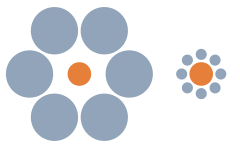
Ebbinghaus illusion: the orange circle on the left appears smaller than that on the right, but they are in fact the same size.
-

Café wall illusion: the parallel horizontal lines in this image appear sloped.
-

Checker version: the diagonal checker squares at the larger grid points make the grid appear distorted.
-

Lilac chaser: if the viewer focuses on the black cross in the center, the location of the disappearing dot appears green.
-

Motion illusion: contrasting colors create the illusion of motion.
-

Watercolor illusion: this shape's yellow and blue border create the illusion of the object being pale yellow rather than white[1]
-
.gif)
Optical illusion disc which is spun displaying the illusion of motion of a man bowing and a woman curtsying to each other in a circle at the outer edge of the disc, 1833
-

A hybrid image constructed from low-frequency components of a photograph of Marilyn Monroe (left inset) and high-frequency components of a photograph of Albert Einstein (right inset). The Einstein image is clearer in the full image.
-

An ancient Roman geometric mosaic. The cubic texture induces a Necker-cube-like optical illusion.
-
a set of colorful spinning disks that create illusion. The disks appear to move backwards and forwards in different regions.
-
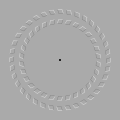
The two circles seem to move when the viewer's head is moving forwards and backwards while looking at the black dot.[6]
-
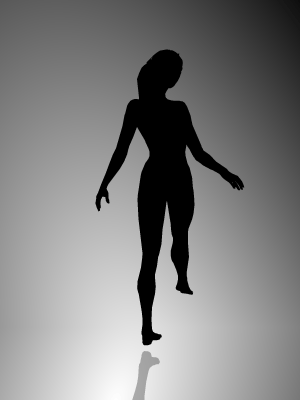
The Spinning Dancer appears to move both clockwise and counter-clockwise
- ^ Bangio Pinna; Gavin Brelstaff; Lothar Spillman (2001). "Surface color from boundaries: a new watercolor illusion". Vision Research. 41 (20): 2669–2676. doi:10.1016/s0042-6989(01)00105-5. PMID 11520512.
- ^ Hoffmann, Donald D. (1998). Visual Intelligence. How we create what we see. Norton., p.174
- ^ Stephen Grossberg; Baingio Pinna (2012). "Neural Dynamics of Gestalt Principles of Perceptual Organization: From Grouping to Shape and Meaning" (PDF). Gestalt Theory. 34 (3+4): 399–482.
- ^ Pinna, B., Gregory, R.L. (2002). "Shifts of Edges and Deformations of Patterns". Perception. 31 (12): 1503–1508. doi:10.1068/p3112pp. PMID 12916675.
- ^ "Pinna illusion". scholarpedia.org.
- ^ Baingio Pinna; Gavin J. Brelstaff (2000). "A new visual illusion of relative motion" (PDF). Vision Research. 40 (16): 2091–2096. doi:10.1016/S0042-6989(00)00072-9. PMID 10878270.
See also
- Auditory illusion
- Barberpole illusion (Barber's pole)
- Camouflage
- Chronostasis (stopped-clock illusion)
- Closed-eye hallucination/visualization
- Contingent perceptual aftereffect
- Contour rivalry
- Emmert's law
- Entoptic phenomenon
- Flashed Face Distortion Effect
- Gravity hill
- Human reactions to infrasound
- Hidden faces
- Hybrid image
- Illusion
- Infinity edge pool
- Kinetic depth effect
- Mirage
- Multistable Perception
- Necker cube
- Silencing
- Troxler's fading
- Visual space
- The dress
- Watercolour illusion
Notes
- ↑ Pisters, Patricia (2011). The Neuro-Image: A Deleuzian Film-Philosophy of Digital Screen Culture, p.80. Stanford. ISBN 9780804782845.
- ↑ "After Images". worqx.com.
- ↑ Pinel, J. (2005) Biopsychology (6th ed.). Boston: Allyn & Bacon. ISBN 0-205-42651-4
- ↑ Howe, Catherine Q.; Yang, Zhiyong; Purves, Dale (2005). "The Poggendorff illusion explained by natural scene geometry". PNAS. 102 (21): 7707–7712. doi:10.1073/pnas.0502893102.
- 1 2 Pelak, Victoria. "Approach to the patient with visual hallucinations". www.uptodate.com. Retrieved 2014-08-25.
- ↑ Gersztenkorn, D; Lee, AG (Jul 2, 2014). "Palinopsia revamped: A systematic review of the literature.". Survey of ophthalmology. 60: 1–35. doi:10.1016/j.survophthal.2014.06.003. PMID 25113609.
- ↑ David Eagleman (April 2012). Incogito: The Secret Lives of the Brain. Vintage Books. pp. 33–. ISBN 978-0-30738992-3. Retrieved 14 August 2013.
- 1 2 Myers, D. (2003). Psychology in Modules, (7th ed.) New York: Worth. ISBN 0-7167-5850-4
- ↑ Yoon Mo Jung and Jackie (Jianhong) Shen (2008), J. Visual Comm. Image Representation, 19(1):42-55, First-order modeling and stability analysis of illusory contours.
- ↑ Yoon Mo Jung and Jackie (Jianhong) Shen (2014), arXiv:1406.1265, Illusory shapes via phase transition.
- ↑ Bressan, P (2006). "The Place of White in a World of Grays: A Double-Anchoring Theory of Lightness Perception". Psychological Review. 113 (3): 526–553. doi:10.1037/0033-295x.113.3.526.
- ↑ Bernal, B., Guillen, M., & Marquez, J. (2014). The spinning dancer illusion and spontaneous brain fluctuations: An fMRI study. Neurocase (Psychology Press), 20(6), 627-639.
- ↑ Tanca, M.; Grossberg, S.; Pinna, B. (2010). "Probing Perceptual Antinomies with the Watercolor Illusion and Explaining How the Brain Resolves Them". Seeing & Perceiving. 23 (4): 295–333. doi:10.1163/187847510x532685.
- ↑ Bach, Michael (16 August 2004 (last update 2010-01-04)). "Shepard's "Turning the Tables"". http://www.michaelbach.de/ot/index.html 86 Optical Illusions & Visual Phenomena. Michael Bach. Archived from the original on 27 January 2010. Retrieved 27 January 2010. Check date values in:
|date=(help); External link in|work=(help) - 1 2 Key to All Optical Illusions Discovered, Jeanna Bryner, Senior Writer, LiveScience.com 6/2/08. His research on this topic is detailed in the May/June 2008 issue of the journal Cognitive Science.
- ↑ Gregory, Richard L. "Knowledge in perception and illusion" (PDF).
Further reading
- Visual illusions:An Empirical Explanation Dale Purves et al. Scholarpedia 3(6):3706. doi:10.4249/scholarpedia.3706
References
- Changizi, Mark A.; Hsieh, Andrew; Nijhawan, Romi; Kanai, Ryota; Shimojo, Shinsuke (2008). "Perceiving the Present and a Systematization of Illusions" (PDF). Cognitive Science. 32 (3): 459–503. doi:10.1080/03640210802035191.
- Eagleman, D. M. (2001). "Visual Illusions and Neurobiology" (PDF). Nature Reviews Neuroscience. 2 (12): 920–6. doi:10.1038/35104092. PMID 11733799.
- Richard, Gregory (1997). "Knowledge in perception and illusion" (PDF). Phil. Trans. R. Soc. Lond. B. 352: 1121–1128.
- Purves, D., Lotto, B. (2002) Why We See What We Do: An Empirical Theory of Vision. Sunderland, MA: Sinauer Associates.
- Purves, D.; Lotto, R.B.; Nundy, S. (2002). "Why We See What We Do". American Scientist. 90 (3): 236–242.
- Purves, D.; Williams, M. S.; Nundy, S.; Lotto, R. B. (2004). "Perceiving the intensity of light". Psychological Rev. 111: 142–158. doi:10.1037/0033-295x.111.1.142.
- Renier, L.; Laloyaux, C.; Collignon, O.; Tranduy, D.; Vanlierde, A.; Bruyer, R.; De Volder, A. G. (2005). "The Ponzo illusion using auditory substitution of vision in sighted and early blind subjects". Perception. 34 (7): 857–867. doi:10.1068/p5219. PMID 16124271.
- Renier, L.; Bruyer, R.; De Volder, A. G. (2006). "Vertical-horizontal illusion present for sighted but not early blind humans using auditory substitution of vision". Perception & Psychophysics. 68: 535–542. doi:10.3758/bf03208756.
- Yang, Z.; Purves, D. (2003). "A statistical explanation of visual space". Nature Neuroscience. 6: 632–640. doi:10.1038/nn1059.
- Dixon, E.; Shapiro, A.; Lu, Z. (2014). "Scale-Invariance in brightness illusions implicates object-level visual processing". Scientific Reports. 4. doi:10.1038/srep03900.
External links
| Wikimedia Commons has media related to Optical illusion. |
- Optical illusions and perception paradoxes by Archimedes Lab
- Optical Illusions Categorized by Just-Riddles.net
- Project LITE Atlas of Visual Phenomena
- Autokinetic optical illusions, on Smithsonian Magazine
- Akiyoshi's illusion pages Professor Akiyoshi KITAOKA's anomalous motion illusions
- Spiral Or Not? by Enrique Zeleny, Wolfram Demonstrations Project
- Still images that move by Op Artist Gianni A. Sarcone
